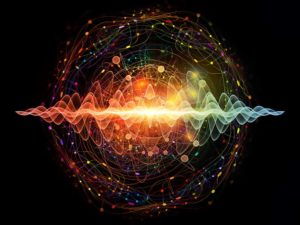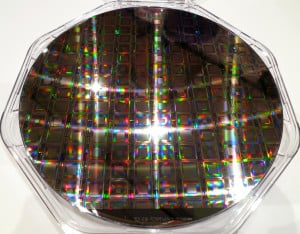The phenomenon of quantum entanglement was introduced to me during my undergraduate days at UCLA in classes in physics and physical chemistry. I, along with scores of other people, have been mulling over the disturbing consequences ever since.
If quantum physics were discovered today, we might use the term digital instead of quantum to describe the fundamental assumption of this branch of science. This fundamental assumption claims that the energy level of particles, like electrons, can only take on certain fixed values. We contrast digital devices with analog ones in that analog devices do not have this inherent limitation. When James Whistler painted his mother in 1871, he could produce an infinite number of shades of gray and black from his artist’s palette, but if you look at a reproduction of “Whistler’s Mother” on your computer monitor, there are only 256 shades of gray to choose from.
The notion that our actual, real, physical world is somehow digitized at its most fundamental submicroscopic level was a revolution in physics. On “Spinal Tap,” the amplifiers go up to 11, but you can surely set them between 10 and 11 if you need a volume of 10.5 and 11 is too loud. An electron can be a 10 or 11 in energy, but it cannot exist as 10.5. This is what we mean by quantum physics. It is digital, not analog.
I think it is important to sort this out because the word quantum is so strange and sci-fi sounding that it becomes difficult to understand how the universe operates unless we realize that quantum is just an old-timey word for digital.
When light travels, we can think of it as a stream of individual tiny dots of photons, or as a wave, like ripples on a pond. Both approaches are correct, although in the macroscopic world we live in, it is hard to imagine something being both a tiny rock and also waves on a pond when you throw that rock in. When light travels, the wave can go up and down or side to side at any specific angle. The angle at which a light wave is traveling through space is called its angle of polarization. If you go to the drugstore and buy a pair of “polarized” sunglasses, what you’re really getting is something like a picket fence with a long series of parallel lines. This only lets light through with an angle of polarization which is somewhat close to that of the polarizing filter. Light at opposite angles is blocked. Imagine throwing a Frisbee through the gaps in a picket fence with the slats as far apart as half the width of the Frisbee. If you throw the Frisbee perfectly level against the fence it will be blocked. But if you throw it at a 45 degree angle, it might make it through and it might not. If you throw it perfectly up and down, it will always go through. The physics of polarizers is that once the Frisbee makes it through, it is as if it bounced against the slats and now flies at an angle equal to that of the polarizer. So our 45 degree angle Frisbee, if it did make it through the fence, would be flying straight up and down, since that is the angle of the fence slats.

Once photons are entangled, they become related in a way that defies classical physics. The polarization will remain the same, however great the distance becomes, because when the wave function collapses, it will represent the same moment in time for the entire wave front.
We’re fairly used to the digital world nowadays, but the entanglement part of quantum entanglement is hard to accept. Many physical processes will produce not one, but a pair of tiny particles, such as photons. Pairs of photons can be produced in the lab which are entangled. What this means is that if you measure the angle of polarization of one photon, for example, by seeing if it passes through a filter at 45 degrees, then the other photon will also pass a 45 degree polarization filter. Whatever direction of polarization you measure from one photon of an entangled pair, if it makes it through the filter, then the other photon will also make it through the same angle, all the time.
Well, maybe that’s not so weird. After all, pairs of shoes are entangled. If you go to Nordstrom and buy a pair of size 10 shoes and randomly mail one to the mayor of Buffalo, when he opens it he immediately knows you have a size 10 shoe back home.
But quantum physics teaches us that photons have not decided which way they are polarized until we measure them. If you asked one photon from an entangled pair, “Hey, I’m thinking about putting a polarizing filter in front of you. Which way are you polarized?” The photon will answer, “I have not decided.” Here’s an analogy. Consider a married couple where both parties decide to always vote the same on all issues. This keeps arguments down and double the vote is better. The husband says, “I don’t care who I vote for. I’m just going to vote the same as my wife.” The wife says she doesn’t care, but she is voting the same as her husband. The two are entangled, in physics terms. So if you ask her, “Which way are you leaning on Prop 24 to raise the drinking age?” She answers, “Well, I’m just voting the same as my husband.” Only when you put the ballot in front of her and say, “Ok, now you must vote” will she vote, and she says, “Well, if my husband has not voted, I’ll just vote at random.” So, let’s say she randomly votes yes on the proposition.
Immediately, and when I say immediately, I mean it, the husband, if you give him a ballot, will also vote yes. If you give him a ballot a billionth of a second after his wife votes and he is a trillion miles away, he will vote yes. But if she voted no, he will also vote no. This is entanglement.
Most of us, and I’ll include Albert Einstein in that group, think this is pretty strange. In a paper he coauthored in 1935 with Boris Podolsky (who did most of the writing) and Nathan Rosen (who taught at the University of North Carolina at Chapel Hill where I attended medical school), the three of them speculated that each particle secretly “knows” how it is polarized and the way it responds to measurement is not random. It is difficult to get three Jews to agree on anything, but these three nice Jewish physicists all felt that quantum theory was flawed. The husband and wife don’t vote at random. They secretly know how they are going to vote beforehand.
Einstein, Podolsky, and Rosen’s idea, known as the EPR paradox was challenged by John Bell, a colleague of Einstein’s and grandfather to the singer Olivia Newton John. He postulated an experiment where we could tell if there were hidden instructions inside these particles telling them in advance how to behave. The basic idea, returning to our voting analogy, was to send slightly different ballots to the husband and wife. On his ballot, prop 47 is to raise gas taxes by 10 cents for the I-90 bridge, but on her ballot, it is to raise taxes 10 cents per gallon on a bridge in Spokane. The wife’s attitude is, “If my husband has already voted and you give me the exact same ballot proposition you gave him, I will vote the same, and if you give me a completely unrelated question, like making December 21st National Flashlight Day, then I will vote randomly, but if you give me a ballot question that is sort of like what my husband got, the component which is similar to my husband will make me vote like him, and the component which is different will make me vote randomly, so it really just depends on how close my ballot initiative is to his.”
In experiments on photons, instead of asking them ballot questions, we measure their polarization at different angles. For one photon, we measure it directly at 90 degrees and see if it passes or is blocked by the filter. For the other photon of the entangled pair, we might change the angle, maybe by 22.5 degrees and measure it. The math from Einstein’s version, where each photon secretly “knows” how to respond, and the math from the quantum physics version, where each photon randomly responds but matches its entangled pair, offer different predictions.
Physicists do agree on the phenomenon of entanglement,
but the meaning behind it is illusive.
In Einstein’s version, if the polarization filters are offset by a 45 degree angle, the entangled photons should either both pass or both not pass the filter 5/9 of the time. In the quantum physics version, they should both pass or not pass 50% of the time. That might not seem like a huge numerical difference, but if you run a few thousand photons through the experiment, it is more than plenty to see who is correct, and in this case, Einstein was wrong and Olivia Newton John’s grandfather was correct.*
What this means is that a pair of electrons or photons can be a million miles apart, and if you measure a feature of one of the entangled photons, the other will somehow “know” and change its behavior instantaneously.
You can tear your hair out trying to figure out how this is possible and there is no uniform agreement. Physicists do agree on the phenomenon of entanglement, but the meaning behind it is illusive. The approach I like best is to consider that these particles do not have the same concept of space and time that we do. The two entangled particles might be far apart in our 3-dimensional universe, but in some higher dimensional construct, they are still right next to each other, or they exist outside of time. The “system” of the two photons traveling apart in our 3-dimensional world is the size of a tiny point in a different dimension.
Although it is not science, the notion of entanglement in our everyday world is an intriguing one. In high school, my best friend Harris Kane and I were quantumly entangled since we shared the same sense of humor and mostly the same thoughts. If he laughed at something, I would laugh. If he rolled his eyes, so would I. More recently, another best friend, Jon and I went through a phase when we were quantumly entangled. Two bodies, but really one brain. Sometimes, I feel quantumly entangled up with a patient. Maybe we’re knee deep in some life tragedy and we’ve invested a dozen hours of mental health care together on the problem. I am most effective when I can sense what my patient is thinking and the patient knows what I am thinking as well, when we are both responding instantaneously to what we are discussing. It isn’t really quantum entanglement, or maybe it is.
*For the mathematically inclined, the actual chance of both photons passing or being blocked by the different polarizers is cos^2 (theta) where theta is the angle between the photons. An angle of zero degrees means a cosine of 1 and 100% agreement, which is what we expect from the physics of optics if both polarizers are at the same angle. Similarly, an angle of 90 degrees is a cosine of zero and always produces opposite outcomes. An angle of 45 degrees is a cosine of 0.707 which, squared, is 0.5, or a 50% chance the photons will both pass or both be blocked.


